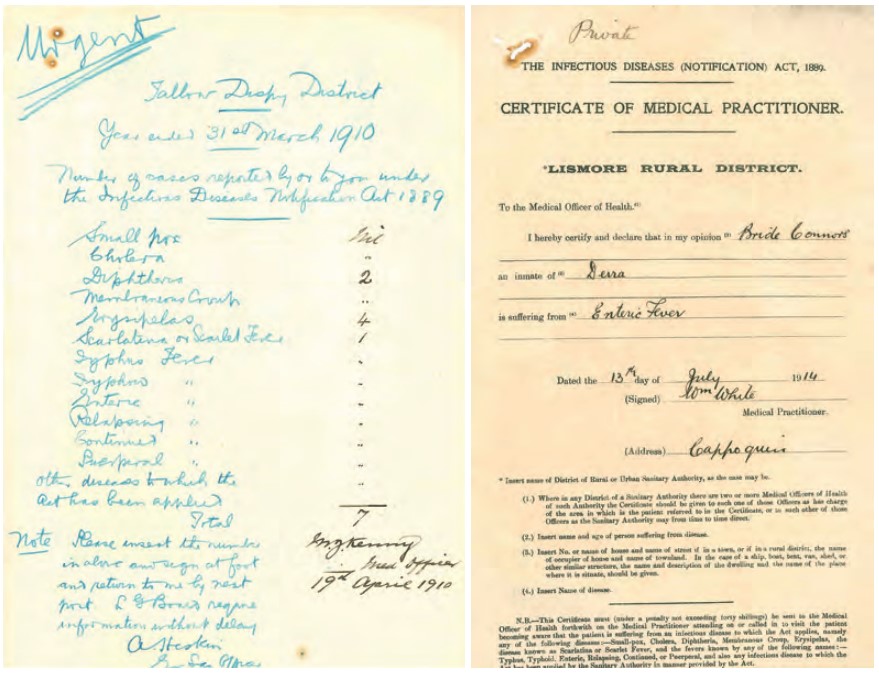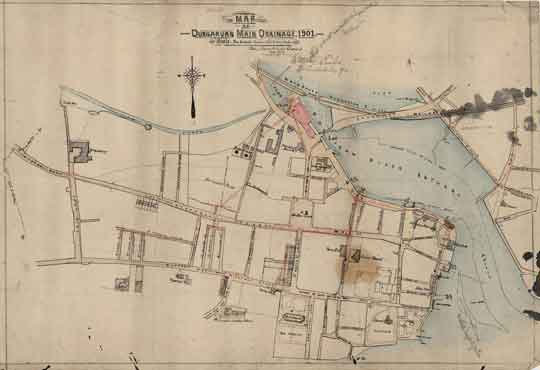THE SIGNIFICANCE OF THE SANITARY OFFICER
Published in Issue 2 (March/April 2023), Volume 31By Joanne Rothwell
Sanitary officers were among the frontline workers of the nineteenth century and were key in preventing the spread of infectious diseases and improving the health and welfare of the population of Ireland. The Public Health (Ireland) Act, 1878, consolidated earlier legislation. According to Desmond Roche in Local government in Ireland (1982):
‘This Act was drafted under the influence of the theories of the causes of disease current at the time. Its remedy against the spread of infectious diseases was the creation of clean surroundings by eliminating nuisances, cleansing infected premises, providing water supplies, drainage and proper burial grounds, reducing overcrowding in houses, destroying unsound food, regulating slaughter houses and dealing with infectious diseases in hospitals.’
There had been previous legislation on providing towns with water, establishing fever hospitals, preventing contagious diseases and promoting public health. In fact, the 1878 Act was an update of the Public Health Act of 1874. Among the collections of local authority archives services are minutes of the sanitary committees, some of them commencing with that earlier Act in 1874. These records hold a wealth of valuable information not just on disease and sanitation but also on living conditions, particularly for those living in poverty.

Above Left: Return of infectious diseases for Tallow Dispensary District, 19 August 1910. Above Right: : ‘Certificate of Medical Practitioner’ for a case of enteric fever in Cappoquin, 13 July 1914.
The work of the sanitary committee combined medical assessments and analysis with the development of local infrastructure to combat the spread of disease and improve public health. The team included an executive sanitary officer, sanitary officer, sanitary sub-officers and, in some cases, a consulting sanitary officer. In Waterford City the role of executive sanitary officer was held by the town clerk, the sanitary officer was the borough high sheriff and the sub-officers were the borough constables. The consulting sanitary officer was Dr De Landre.
In Dungarvan Urban District Council the sanitary committee minutes begin in 1874. Having settled the salary of the dispensary doctor, Mr Henry Anthony, at £10 per annum as urban sanitary officer and inspector of nuisances, and that of Thomas Walsh as sub-sanitary officer at £5 per annum, the committee set to work on dealing with the many issues of public health in the community. The sanitary sub-officers visited the sites of reported nuisances and disease, and their reports provide an insight into the living conditions of the time. On 11 June 1875 the sanitary officer reported that ‘cess pools, bad sewerage and other nuisances were at the rear of houses in Bridge Street and Victoria Lane, Abbeyside, the property of Sir J.N. Humble. Ordered that the landlord be noticed to abate the nuisance.’
In August 1881 in Waterford City Dr De Landre and the high constable, James Mahony, reported to the sanitary committee on houses at the corner of Little Patrick Street
‘… from which the first cases of fever in the present epidemic were removed to Hospital. These houses are let to tenements and considerably over 100 people adults and children live in these. Two rooms are allotted to each family one a sleeping compartment and the other is reserved for kitchen purposes … The trade followed by nearly all the occupants is shoemaking and what should be the kitchen is also the workshop and from the nature of their business the air is always heavy and offensive in the kitchen.’
The assessments of the sanitary officers could be quite blunt. On 15 April 1889 in Dungarvan James C. Holland, medical officer, wrote of one house visited: ‘It is extremely filthy. And further, these people stable a donkey there. And all the inmates appear to be strangers to clean water.’ The most common issues highlighted in the records were in relation to ‘heaps of manure’, ‘filthy ash pits’, ‘cess pools’, ‘bad sewerage’ and ‘poor drainage’. Poor sanitation and overcrowding were huge problems in urban and rural areas.
These poor conditions were also being shown in the records to affect the health of the population, and the outbreaks of diseases were recorded and followed up to trace their cause and origin. Dispensary doctors provided returns of illnesses and outbreaks of disease, which were then followed up by the sanitary officers to discover the source of an outbreak. In Dungarvan an outbreak of enteric fever in 1901 resulted in the medical inspector from the Local Government Board, Dr Browne, reporting on the defective sewerage in the town, which was held to be the cause of the outbreak. This led to the Board granting the loan required to provide a new sewerage scheme for Dungarvan in 1901. The town engineer, Michael Beary, produced a set of maps for this new drainage scheme, providing a detailed colour map of the town which marked the proposed new pipes and at the same time recorded the streets in 1901.
The Local Government Board was also able to warn the network of sanitary committees of possible outbreaks of epidemics and enable them to start preparations to prevent or limit them. In 1892 the Board issued guidelines on a possible outbreak of cholera to all sanitary areas, and in March 1893 Dr Browne, the local government inspector, attended the sanitary committee in Waterford City to communicate the arrangements that should be made in view of the probable approach of cholera.
These detailed accounts of infectious diseases, housing conditions, health and the provision of water and sewerage infrastructure throughout Ireland are a rich source of information about life in Ireland in the late nineteenth and early twentieth centuries. The sanitary officers’ reports identify families that as short-term tenants in poor tenement houses would not be recorded in rate books. They enable researchers to investigate the landlords to whom notices were served and the quality of the housing available. A search through these records can reveal some fascinating stories yet to be told.
Joanne Rothwell is Waterford City and County Archivist.

















